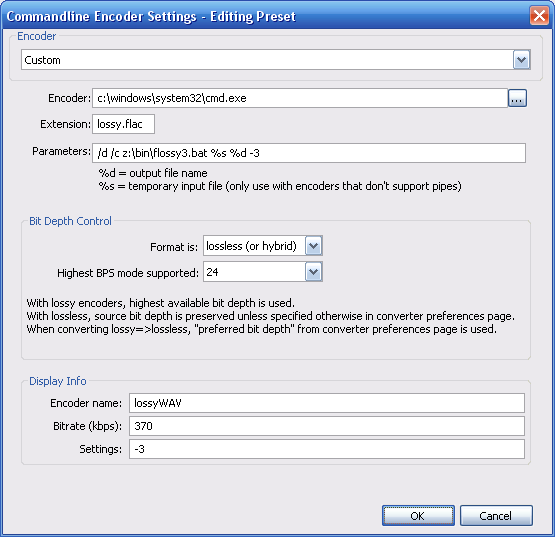LossyWAV: Difference between revisions
| Line 31: | Line 31: | ||
==Supported input formats== | ==Supported input formats== | ||
*[[WAV]]: 16bit, 24-bit; Samplerate ≥ 32kHz [[Pulse Code Modulation|PCM]]. Very high sample rates (&gg 48kHz) have not been extensively tested. Tunings have been focussed on 16bit, 44.1kHz samples (i.e. CD PCM). | *[[WAV]]: 16bit, 24-bit; Samplerate ≥ 32kHz [[Pulse Code Modulation|PCM]]. Very high sample rates (≫ 48kHz) have not been extensively tested. Tunings have been focussed on 16bit, 44.1kHz samples (i.e. CD PCM). | ||
==Known supported codecs== | ==Known supported codecs== | ||
Revision as of 09:35, 4 December 2007
| lossyWAV | |
|---|---|
| lossy pre-processor | |
| Developer(s) | Nick.C |
| Release | TBC |
| Type | Lossy |
| Recommended encoder | latest |
| Website | Hydrogenaudio |
lossyWAV is a lossy pre-processor for audio. It reduces bit depth of the input signal, which, when used in conjunction with certain lossless codecs, reduces the bitrate significantly compared to unpreprocessed compression. lossyWAV's primary goal is to maintain transparency with a high degree of confidence when processing any audio data.
History
lossyFLAC was an experiment started by 2Bdecided with the aim of transparently reducing audio bit depth (making some lower bits zero), thereby taking advantage of FLAC's detection of consistently zeroed lower sample bits within each single frame, increasing coding efficiency.[1]
Nick.C ported the original MATLAB implementation to Delphi, and lossyFLAC proved itself to work with other lossless codecs, so the application name was changed to lossyWAV. Since then, Nick.C has heavily developed and built upon lossyWAV, with tuning performed with the help of halb27.
Naming
lossyWAV-processed files are usually named with a double filename extension, to make them instantly identifiable. e.g. ".lossy.flac" would indicate an audio file which was processed using lossyWAV, and subsequently encoded using FLAC.[2]
Combinations of lossyWAV with each specific encoder are referred to as lossyX, where X is an abbreviation of the lossless codec name. Combination names are listed in the "known supported codecs" section below.
Presets
- -1: Highest quality preset, disc space-saving alternative to lossless archiving for large audio collections.
- -2: General usage; a compromise between -1 and -3.
- -3: High quality preset for usage on a compatible DAP, approx. 350kbps for "normal" music.[3] A comparison of portable media players is here, which shows FLAC and WMA Lossless compatibility among listed players.
Presets are, of course, not limited to these example uses. Preset -3 has proven to be more than acceptable for people who have been closely involved with development. It is up to the user to decide which preset to use for their own purposes.
Supported input formats
- WAV: 16bit, 24-bit; Samplerate ≥ 32kHz PCM. Very high sample rates (≫ 48kHz) have not been extensively tested. Tunings have been focussed on 16bit, 44.1kHz samples (i.e. CD PCM).
Known supported codecs
| Codec | lossyWAV parameters | Encoder parameters | Combination name |
|---|---|---|---|
| FLAC | — | -b 512 | lossyFLAC |
| LPAC | — | -b512 | lossyLPAC |
| MPEG-4 ALS | — | -l -n512 | lossyALS |
| TAK | — | -fsl512 | lossyTAK |
| WavPack | — | --blocksize=512 | lossyWV |
| WMA Lossless | -wmalsl (same as -cbs 2048) | — | lossyWMALSL |
Known unsupported codecs
lossyWAV application settings
lossyWAV beta v0.5.5 : WAV file bit depth reduction method by 2Bdecided.
Delphi implementation by Nick.C from a Matlab script, www.hydrogenaudio.org
Usage : lossyWAV <input wav file> <options>
Example : lossyWAV musicfile.wav
Quality Options:
-1 extreme settings [4xFFT] (-cbs 512 -nts -2.0 -skew 36 -snr 21
-spf 22224-22225-11235-11246-12358 -fft 11011)
-2 default settings [3xFFT] (-cbs 512 -nts +1.5 -skew 36 -snr 21
-spf 22224-22235-22346-12347-12358 -fft 10101)
-3 compact settings [2xFFT] (-cbs 512 -nts +6.0 -skew 36 -snr 21
-spf 22235-22236-22347-22358-2246C -fft 10001)
Standard Options:
-o <folder> destination folder for the output file
-nts <n> set noise_threshold_shift to n dB (-48.0dB<=n<=+48.0dB)
(-ve values reduce bits to remove, +ve values increase)
-force forcibly over-write output file if it exists; default=off
Codec Specific Options:
-wmalsl optimise internal settings for WMA Lossless codec; default=off
Advanced / System Options:
-snr <n> set minimum average signal to added noise ratio to n dB;
(-215.0dB<=n<=48.0dB) Increasing value reduces bits to remove.
-skew <n> skew fft analysis results by n dB (0.0db<=n<=48.0db) in the
frequency range 20Hz to 3.45kHz
-fft <5xbin> select fft lengths to use in analysis, using binary switching,
from 64, 128, 256, 512 & 1024 samples, e.g. 01001 = 128,1024
-spf <5x5hex> manually input the 5 spreading functions as 5 x 5 characters;
These correspond to FFTs of 64, 128, 256, 512 & 1024 samples;
e.g. 22235-22236-22347-22358-2246C (Characters must be one of
1 to 9 and A to F (zero excluded).
-cbs <n> set codec block size to n samples (512<=n<=4608, n mod 32=0)
-quiet significantly reduce screen output
-nowarn suppress lossyWAV warnings
-detail enable detailled output mode
-below set process priority to below normal.
-low set process priority to low.
Special thanks:
David Robinson for the method itself and motivation to implement it in Delphi.
Dr. Jean Debord for the use of TPMAT036 uFFT & uTypes units for FFT analysis.
Halb27 @ www.hydrogenaudio.org for donation and maintenance of the wavIO unit.
Example Foobar2000 Converter Settings
Example flossy.bat file called from above converter settings.
@echo off c:\data_nic\bin\lossyWAV %1 %3 %4 %5 %6 %7 %8 %9 -below -nowarn -quiet c:\data_nic\bin\flac.exe -8 -f -b 512 "%~N1.lossy.wav" -o"%~N2.flac" del "%~N1.lossy.wav"
Frequently asked questions
- Question: Is it VBR?
- Short answer: Yes.
- Question: Is it transparent?
- Short answer: Almost certainly.
- Question: Is it lossless?
- Short answer: No.
- Question: Why should I use this?
- Answer:
External links
- Current development thread
- Original lossyFLAC thread (no longer used)

